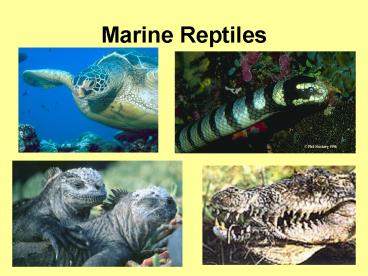Marine Reptiles - PowerPoint PPT Presentation
1 / 32
Title:
Marine Reptiles
Description:
Marine Reptiles General Characteristics of Class Reptilia Dry scaly skin to protect against water loss Lay eggs Sex is determined by the temperature of the ... – PowerPoint PPT presentation
Number of Views:195
Avg rating:3.0/5.0
Title: Marine Reptiles
1
Marine Reptiles
2
(No Transcript)
3
- The first vertebrates originated in the ocean
- About 350 million years ago,
- vertebrates came onto land
- Descended from bony fishes
4
(350 MYA)
(285 MYA)
(200 MYA)
5
- Harsher conditions ashore
- -no more water for support
- -developed new ways to move
- All land vertebrates evolved two pairs of limbs
- Called tetrapods four-footed(even snakes)
- Evolved lungs ways to stay moist
6
General Characteristics of Class Reptilia
- Dry scaly skin to protect against water loss
- Lay eggs
- Sex is determined by the temperature of the
environment at a time during develop. - Ectothermic
- Body temperature is regulated by environment and
behavior - Basking in sunlight to warm and swimming to cool
off - Limited to tropical and subtropical habitats
7
Adaptations of Reptiles to Land
- Lungs for breathing so cannot obtain oxygen from
water - Amniotic egg-large yolk to nourish its young and
a leathery shell to prevent dessication - Internal fertilization and eggs laid on land
- 3 or 4 chambered hearts (more efficient at
circulating oxygenated blood)
8
Adaptations of Reptiles to Land
- Salt glands- remove salt from their blood
- Found above eyes
- Salt excretions help conserve water and wash sand
form their eyes - Concentrated urine to conserve water
9
Order Crocodilia
- Most advanced of all reptiles
- Female lays eggs in a nest and provides limited
care for its young for several wks - Eyes and nostrils are positioned to be above
water while croc is submerged - Well developed senses (but cannot see underwater)
- Opportunistic predators (carnivorous)
- Food is mostly stored as fat and they can go
years without a meal
10
Order Squamata- snakes
- All species of sea snake are venomous
- 1 to 2 meters in length
- Flattened body side to side and paddle tail aid
in swimming - Some have live birth others must lay eggs on land
- Lungs are highly inflatable and they can dive for
2 hours
11
Order Squamata- Iguana
- Amblyrhynchus subcristatus
- Live on the Galapagos Islands southwest of South
America - Dive in cold water to find algae to eat
- Warm up by basking in sun
- Remove salt w/ salt glands
- Under threat by human introduced animals like
cats, dogs and rats and human pollution
12
Order Chelonia
- Sea turtles are the most widely distributed
reptile - All species are endangered
13
Order Chelonia
- Sea Turtles
14
Biology
- Found year round in the tropics but higher
latitude in the summer - Most feed in shallow water
- Long migrations between feeding and breeding
grounds - Males spend entire life at sea, females return to
land to lay eggs - Nest every other year and a couple of times a
season
15
(No Transcript)
16
(No Transcript)
17
Life Cycle
- 50-170 eggs , 6-13 weeks to hatch
- Emergence is typically at dusk and hatchlings
head towards the brightest horizon - Lost years- lead largely pelagic existence
- Females return to natal breeding ground
- Live more than 50 yrs, repro. between 10 and 30
yr old
18
Sea Turtle Body Plan
- Differ in size, pattern of scales on the shell
- Sea turtles can survive up to 200 yrs
- Body plan is well adapted to marine environment
- Fatty deposits for buoyancy
- Light bones for buoyancy
- Streamlined shells and flippers
- Dive up to 40 minutes
19
(No Transcript)
20
LeatherbackDermochelys coriacea
- 6 ft long
- Feed on jellyfish
21
GreenChelonia midas
- 3.3 ft
- Juveniles eat molluscs, crustaceans and jellyfish
- Adults eat seagrass and algae
22
LoggerheadCaretta caretta
- 3 ft long
- Eat benthic crustaceans and molluscs
23
HawksbillEretmochelys imbricata
- 2-3 ft long
- Eat sponges and benthic invertebrates
24
Kemps RidleyLepidochelys kempii
- 2-2.6 ft long
- Eat crabs, shrimp and molluscs
25
Sea Turtle Nesting Behavior
- Use their flippers to dig a hole once they select
a nesting site - Eggs are laid into the hole and covered with sand
- 2 months later the eggs hatch
- Between hatching and 20 years of age are the lost
years
26
Hatching Success
- Nests with temps below 28.7 produce mostly males
- At risk for predation
- Risk of suffocation
- Risk of drowning
- 80 Hatch success rate
- Only 1 or 2 turtles survive to maturity
27
Human Interactions
- Developing and building on the shoreline
- Commercial fishing
- Erosion of shoreline
- Disturbing nesting beaches
28
- 4
- 5
29
Common Name Anatomy
Turtles Armor like shell fused to backbone Legs modified as flippers
Crocodile Rarely larger than 20 ft long. Largest reptile
Snakes Flattened, legless, a paddle like tail for swimming
Iguana 4 legs, flattened tail for swimming
30
Feeding
Algae and small invertebrates like jellyfish
Vicious predators
carnivorous
seaweeds
Common Name
Turtles
Crocodile
Snakes
Iguana
31
Examples
7 species Green, hawksbill, leatherback, kemps, etc.
1 species?
55 known species
Galapagos island iguanas
Common Name
Turtles
Crocodile
Snakes
Iguana
32
Life History
Born on land, life in open water, return to land only to lay eggs
Stay on the coast but may migrate to open ocean
Totally marine existence
Live on land, feed on food from the ocean
Common Name
Turtles
Crocodile
Snakes
Iguana































